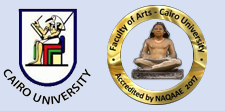عنوان المقال عربي
صيغة الوجوب في النصوص التشريعية باللغتين العربية والإسبانية: أداة حاسوبية للكشف الآلي والتحليل التقابلي
Document Type
Original Study
Subject Area
Language and Literature
Keywords English
Deontic Modality، Legislative language، Contrastive Linguistics، computational linguistics، Corpus linguistics
كلمات مفتاحية عربي
Modalidad deóntica، Lenguaje legislativo، Lingüística contrastiva، Lingüística computacional، Lingüística de corpus
Abstract English
This study presents a computational tool for the automatic detection and analysis of deontic modality (obligation, permission and prohibition) in legislative texts in Arabic and Spanish. The tool is developed in Python and it uses Stanza for text processing in both languages. A comparable corpus of legislative texts has been collected from official data sources. It consists of 5 Spanish legislative texts and their corresponding Egyptian legislative texts including the laws for Traffic, Intellectual Property, Personal Data Protection, Civil Code and the Statute of Labourers. The analysis uncovers the dynamics of how each language expresses the deontic modality within a contrastive framework. It also provides insights on the main linguistic features on how legislative texts express obligation, prohibition or permission from a qualitative and quantitative perspective. Results show that obligation is the most frequent type of deontic modality in legislative texts in both languages. However, in the Arabic corpus the distribution among the three types of deontic modality is more balanced than in Spanish, where the obligation is the dominant type of modality. On the other hand, the ‘verb’ is the Part-of-Speech mostly used to express modality in both languages.
الملخص العربي
يقدم هذا البحث أداة حاسوبية للكشف التلقائي وتحليل صيغة الوجوب والتي تشمل الإلزام والسماح والمنع في النصوص التشريعية باللغتين العربية والإسبانية. وقد تم تطوير الأداة الحاسوبية باستخدام لغة Python ومجموعة Stanza لمعالجة النصوص في كلتا اللغتين. ولتطوير هذه الأداة الحاسوبية تم تجميع ذخيرة لغوية مقارنة (corpus) من النصوص التشريعية المأخوذة عن المصادر الرسمية. تتكون الذخيرة اللغوية من 5 نصوص تشريعية إسبانية والنصوص المقابلة لها من التشريعات المصرية بما في ذلك قوانين المرور وحقوق الملكية الفكرية وحماية البيانات الشخصية والقانون المدني ونظام العمال.يكشف البحث عن ديناميكية كل لغة فيما يختص بكيفية التعبير عن صيغة الوجوب والسمات اللغوية المميزة من خلال إطار تقابلي يعتمد على التحليل الكيفي والكمي. وتظهر النتائج أن صيغة الوجوب الإلزامية هي النوع الأكثر شيوعًا في النصوص التشريعية في اللغتين، إلا أن توزيع أنواع صيغ الوجوب في اللغة العربية تتميز بتوازن أكثر من توزيع هذه الصيغ في النصوص التشريعية الإسبانية. من ناحية أخرى، تعتمد اللغتان على التكوينات التي تستخدم الفعل للتعبيرعن صيغة الوجوب.
Recommended Citation
(2024)
"Deontic Modality in a comparable legislative corpus (Arabic-Spanish): A Tool for Automatic Detection and Contrastive Analysis,"
Journal of the Faculty of Arts (JFA): Vol. 84:
Iss.
2, Article 9.
DOI: https://doi.org/10.21608/jarts.2023.217946.1410
Digital Object Identifier (DOI)
10.21608/jarts.2023.217946.1410
Accept Date
2023-11-22
Publication Date
4-1-2024

